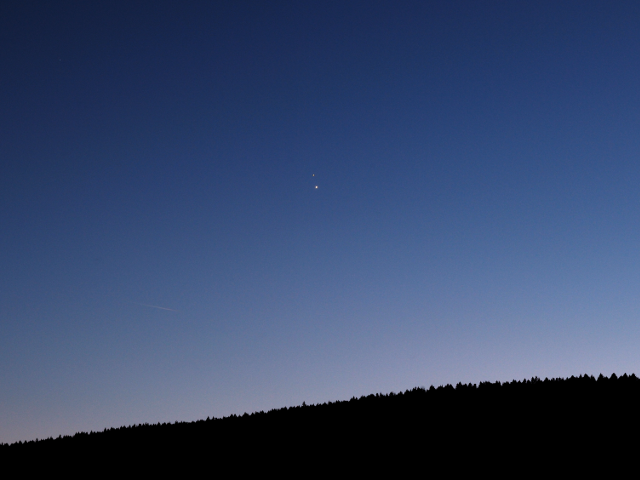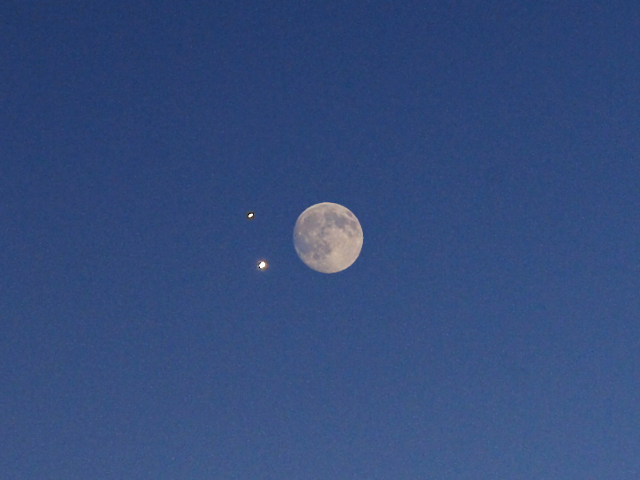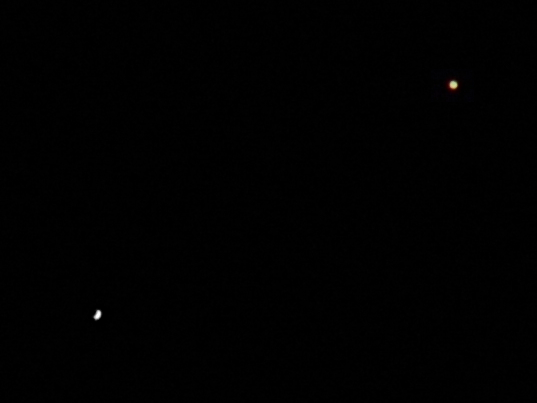« Reading List: Alas, Babylon | Main | Leap Second »
Tuesday, June 30, 2015
Venus and Jupiter at Dusk
Look toward the west a little after sunset today to see a spectacle in the sky: a close conjunction of Venus and Jupiter. Brilliant Venus is at the bottom and bright, but less dazzling, Jupiter is above. This picture was taken with a 50 mm normal lens and approximates the visual appearance. Tonight the planets are separated by only 0.3°, less than the width of the full Moon. To illustrate this, the following is a composite of an image of the conjunction and tonight's near-full Moon, which was rising as the planets were setting. I photographed both at the same scale and overlaid the images.
Brilliant Venus is at the bottom and bright, but less dazzling, Jupiter is above. This picture was taken with a 50 mm normal lens and approximates the visual appearance. Tonight the planets are separated by only 0.3°, less than the width of the full Moon. To illustrate this, the following is a composite of an image of the conjunction and tonight's near-full Moon, which was rising as the planets were setting. I photographed both at the same scale and overlaid the images.
 If you miss the closest conjunction tonight, the planets will remain strikingly close together in the sky for the next few days.
The juxtaposition of the two planets is only apparent. Venus is about 90 million kilometres from the Earth while Jupiter is 890 million kilometres away. Venus is so much brighter than Jupiter (which is more than ten times its size) because it is closer to the Sun and the Earth.
Update: On July 1st, 2015, the conjunction between Venus and Jupiter has widened to around 0.6°, just a bit more than the mean apparent diameter of the full Moon (it varies, due to the Moon's elliptical orbit), but it is still a spectacular sight in the western sky after sunset. Tonight I decided to see if I could take a picture which showed the two planets as they'd appear in a modest telescope. This is somewhat challenging, since Venus is presently 11.5 times brighter (on a linear scale) than Jupiter, and any exposure which shows Jupiter well will hopelessly overexpose Venus. So, I did what any self-respecting astrophotographer would do: cheat. I took two exposures, one best suited for Venus and one for Jupiter, and composited them. This is the result.
If you miss the closest conjunction tonight, the planets will remain strikingly close together in the sky for the next few days.
The juxtaposition of the two planets is only apparent. Venus is about 90 million kilometres from the Earth while Jupiter is 890 million kilometres away. Venus is so much brighter than Jupiter (which is more than ten times its size) because it is closer to the Sun and the Earth.
Update: On July 1st, 2015, the conjunction between Venus and Jupiter has widened to around 0.6°, just a bit more than the mean apparent diameter of the full Moon (it varies, due to the Moon's elliptical orbit), but it is still a spectacular sight in the western sky after sunset. Tonight I decided to see if I could take a picture which showed the two planets as they'd appear in a modest telescope. This is somewhat challenging, since Venus is presently 11.5 times brighter (on a linear scale) than Jupiter, and any exposure which shows Jupiter well will hopelessly overexpose Venus. So, I did what any self-respecting astrophotographer would do: cheat. I took two exposures, one best suited for Venus and one for Jupiter, and composited them. This is the result.
 You can easily see that Venus is a fat crescent, while Jupiter's disc is fully illuminated. The apparent angular diameter of two two planets is almost identical (because enormously larger Jupiter is so much more distant). This was still in late twilight, and I wasn't able to pop out the Galilean satellites. Jupiter would have set before those 4th magnitude objects became accessible.
Both images were taken with a Nikon D600 camera and 25 year old Nikkor 300 mm f/4.5 prime (non-zoom) lens. The image of Venus was taken at f/8 with ISO 1250 sensitivity and 1/1600 second exposure. (Why such high ISO and short exposure? The lens is sharper stopped down to f/8, and the short exposure minimises the chance of vibration or movement of the planet on the sky blurring the image.) The venerable lens has a substantial amount of chromatic aberration, which causes a red fringe around the bright image of Venus. I eliminated this by decomposing the image into its three colour components and using only the green channel, where the lens is sharpest. Since there is no apparent colour visible on Venus, this lost no information.
The Jupiter image was taken with the same camera, lens, aperture, and ISO setting, but at 1/400 second. I clipped the colour image of Jupiter from it and pasted it over the dim smudge which was Jupiter in the Venus image, preserving the relative position of the two planets.
All exposures were made from a fixed (non-guided) tripod in the Fourmilab driveway. (2015-07-01 21:42 UTC)
You can easily see that Venus is a fat crescent, while Jupiter's disc is fully illuminated. The apparent angular diameter of two two planets is almost identical (because enormously larger Jupiter is so much more distant). This was still in late twilight, and I wasn't able to pop out the Galilean satellites. Jupiter would have set before those 4th magnitude objects became accessible.
Both images were taken with a Nikon D600 camera and 25 year old Nikkor 300 mm f/4.5 prime (non-zoom) lens. The image of Venus was taken at f/8 with ISO 1250 sensitivity and 1/1600 second exposure. (Why such high ISO and short exposure? The lens is sharper stopped down to f/8, and the short exposure minimises the chance of vibration or movement of the planet on the sky blurring the image.) The venerable lens has a substantial amount of chromatic aberration, which causes a red fringe around the bright image of Venus. I eliminated this by decomposing the image into its three colour components and using only the green channel, where the lens is sharpest. Since there is no apparent colour visible on Venus, this lost no information.
The Jupiter image was taken with the same camera, lens, aperture, and ISO setting, but at 1/400 second. I clipped the colour image of Jupiter from it and pasted it over the dim smudge which was Jupiter in the Venus image, preserving the relative position of the two planets.
All exposures were made from a fixed (non-guided) tripod in the Fourmilab driveway. (2015-07-01 21:42 UTC)
Posted at June 30, 2015 23:38